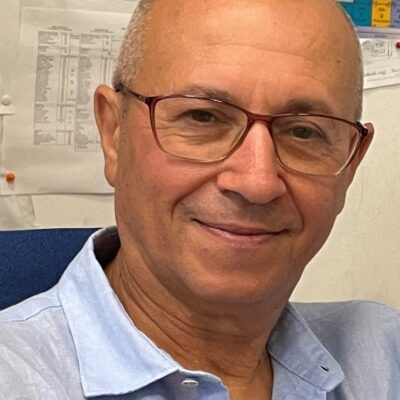Research Director
Pappalardo Giuseppe
Catania

Laurea: Il Dott. Giuseppe Pappalardo ha conseguito la Laurea Magistrale in Biologia (1986) presso l’Università degli studi di Catania (Italia). Formazione Post Lauream: Borsa di studio CNR (1989-1991) per giovani ricercatori. Ha svolto ricerche nella chimica bio-inorganica mediante la progettazione e sintesi di modelli metallo-enzimi ad indirizzo biotecnologico. (1994-2001) Carriera Professionale: Ricercatore presso l’Istituto di Biostrutture e Bioimaging del CNR. (2001-2020) Primo Ricercatore. Dal 2021 Dirigente di Ricerca presso l’Istituto di Cristallografia del CNR. Responsabile del laboratorio di chimica dei peptidi presso l’Istituto di Cristallografia e Principal Investigator di progetti di ricerca Nazionali ed Internazionali finanziati su bandi competitivi, progetti bilaterali CNR-MTA (HAS). Incarichi: E’ stato Responsabile di Sezione Territorialmente Distinta dell’Istituto di Biostrutture e Bioimaging di Catania (incarico conferitogli dal Consiglio di Amministrazione del CNR), in seguito Responsabile di Unità Operativa di sede Secondaria (RUOS) dello stesso Istituto. Professore a Contratto del Corso di Laurea Magistrale in Chimica Biomolecolare “Laboratorio di Sintesi Chimica delle Proteine” presso l’Università degli Studi di Catania. Membro del Collegio dei Docenti del Dottorato Internazionale in Scienze Chimiche. Viaggi Studio: Visiting Scientist presso l’Università del Saarland, a Saarbrucken (Germania) e presso l’Università di Debrecen, a Debrecen (Ungheria). Ricerca: I suoi interessi di ricerca riguardano la sintesi, l’analisi conformazionale, la spettroscopia CD e NMR di peptidi e le loro interazioni con ioni metallici, nonché la sintesi e la caratterizzazione spettroscopica di derivati della ciclodestrina come vettori specifici di composti biologicamente attivi. Attualmente sta studiando il ruolo delle interazioni metallo-peptidi nei disturbi neurodegenerativi e nell’amiloidosi in generale.
Dr. Pappalardo began his scientific career with the synthesis and structural determination of peptides and ß-cyclodextrin derivatives. In this context he deepened his knowledge on synthesis strategies both in solution and on solid phase in the field of peptides and on the chemical methodologies inherent to the functionalization in position 6 of ß-cyclodextrin. He has developed purification methods on a preparative scale and has acquired the fundamentals of various instrumental techniques in particular Nuclear Magnetic Resonance, Mass Spectrometry, Circular Dichroism and UV-Vis Spectroscopy, Potentiometry. The research activity carried out in this area is characterized by a common thread which is to use peptide systems (linear and cyclic) as models for the study of more complex biomolecules. The spectroscopic and thermodynamic study of the complexes formed by these peptides with various metal ions represents, up to now, a valid experimental approach aimed at studying the functional and structural role of metal ions in biological systems with particular regard to metalloproteins. The interest in bio-mimetic chemistry was also articulated through the design and synthesis of molecules containing particular recognition sites: ß-cyclodextrins, due to their macrocyclic structure, possess a hydrophobic cavity capable of forming inclusion complexes with molecules of appropriate size. This ability was exploited through the covalent introduction of appropriate functional groups and / or molecules in the macrocyclic structure of the oligosaccharide. This made it possible to obtain new molecules for drug delivery also endowed with remarkable stereoselective abilities and marked catalytic activity towards suitable substrates. In recent years, his interest has mainly focused on the synthesis and structural characterization of amyloid peptides, with the aim of studying the molecular mechanisms of fibrillogenesis as well as the role of metal ions in neurodegenerative processes and amyloidosis in general. In this context, Dr. Pappalardo optimised the synthesis of peptide systems conjugated with various types of biomolecules, including sugars and porphyrins. The synthetic strategies have been adapted in such a way as to allow an easy introduction of the biomolecules to be conjugated in well-defined regions of the polypeptide chain. All the compounds synthesized up to now have a remarkable neuroprotective capacity and proved capable of recognizing Aß42 in monomeric form, preventing its transition to aggregate forms (oligomers and fibrils). In this phase of his scientific career, Dr. Pappalardo contributed to the establishment of a multidisciplinary group made up of chemists, biologists, physicists and pharmacologists who actively collaborate on the topic of neurodegenerative diseases.
Current research topics are:
1. Synthesis, structural and chemical characterization of exogenous and endogenous molecules against aging and neurodegeneration: applications for diagnosis and therapy.
2. States of aggregation and cytotoxic activity of amyloidogenic systems: molecular studies (structural, kinetic and thermodynamic) and biological activity in vitro and in vivo.
Currently He is leading research activities in the frame of national and international projects, and his scientific production is documented by more than 110 publications including works in journals and books of international relevance.
Dipartimento di Scienze Chimiche Università di Catania, Italia
Dipartimento di Scienze del Farmaco Università di Catania, Italia
Dipartimento di Scienze e Tecnologie Ambientali Biologiche e Farmaceutiche Università degli Studi della Campania “Luigi Vanvitelli”
Dipartimento di Scienze Biomediche e Cliniche, Università degli Studi di Milano
Dipartimento di Scienze Chimiche, Università degli Studi di Padova
Dipartimento di Chimica Materiali ed Ingegneria Chimica “G. Natta” Politecnico di Milano
CNR-IPCF sede di Messina
CNR-SCITEC sede di Roma
CNR-ISMN sede di Messina
CNR-IBB Sede di Napoli
Department of Inorganic and Analtytical Chemistry, University of Debrecen, Hungary
CY Cergy Paris Université, Parigi, Francia
Mazzaglia, Antonino; Di Natale, Giuseppe; Tosto, Rita; Scala, Angela; Sortino, Giuseppe; Piperno, Anna; Casaletto, Maria Pia; Riminucci, Alberto; Giuffrida, Maria Laura; Mineo, Placido G.; Villari, Valentina; Micali, Norberto; Pappalardo, Giuseppe
Giuseppe Di Natale, Giuseppina Sabatino ,Michele Francesco Maria Sciacca ,Rita Tosto, Danilo Milardi and Giuseppe Pappalardo
Balogh B.D.; Szakacs B.; Di Natale G.; Tabbi G.; Pappalardo G.; Sovago I.; Varnagy K.
Consoli G.M.L.; Tosto R.; Baglieri A.; Petralia S.; Campagna T.; Di Natale G.; Zimbone S.; Giuffrida M.L.; Pappalardo G.
Noemi Bognanni Maurizio Viale, Alessia Distefano, Rita Tosto, Nadia Bertola, Fabrizio Loiacono, Marco Ponassi, Domenico Spinelli, Giuseppe Pappalardo, Graziella Vecchio
Sciacca M.F.M.; Di Natale G.; Milardi D.; Pappalardo G.



